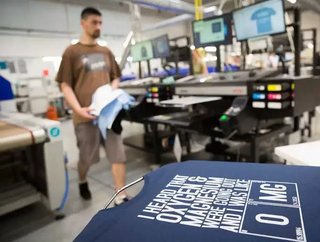Competing with the Amazon behemoth

This spring saw the news that Amazon is pulling back from China. It has struggled against the local competition – Alibaba and JD.com – which can apparently deliver for a fraction of the cost. Whilst we might relish this come down from the e-commerce behemoth, we should still react with a mixture of fear and awe if Amazon appears in our space.
This happened to Spreadshirt in the summer of 2017, when Merch by Amazon arrived in Europe. We were a start-up in Leipzig in 2002, but today Spreadshirt is a €100m, self-expression, e-commerce platform and a big player in Europe. People use us to create clothing and accessories with messages they want the world to see. We then manage the printing, delivery, local taxes, commission payments and fulfilment. In 2017, this equated to nearly 5m printed t-shirts, hoodies, mugs and all sorts of other clothing and accessories, to over 160 countries.
But the arrival of Merch by Amazon was a challenge. I’m old enough to remember the pre-internet world of 28-day delivery schedules. In the internet age, Spreadshirt prints and delivers within two days, but elsewhere in the industry, it can be as long as two weeks. Now Amazon has arrived with its vision to deliver inside two hours; if it can do this, it could take a $1bn share of the market in just a few years.
So, is it possible to survive if Amazon arrives in your market? Can you hope to compete if you’re not as big and established as Alibaba? Here’s what we’ve learnt.
It’s all about delivery
This isn’t just about speed and time slots. It’s about how your delivery compares to the rest of your sector and whether you can benchmark it. We tested ourselves by selling via Amazon and got an insider view of how our operations and delivery work compared to theirs. We discovered that to meet their demanding KPIs we had to put orders from Amazon customers ahead of our own. That was galling, but it improved our operations. The likelihood is though, that this only makes you equal to Amazon, not better. This won’t be enough to survive and compete. So, what else?
SEE ALSO:
Customers love a specialist
No-one loves Amazon, not really. We go there for things we can’t easily find, or for prompt delivery. It is commodity shopping, not a fan experience.
Customers looking for inspiration want a specialist with a clearer choice of goods and expertise. So, to compete against Amazon you need to promote your specialist credentials. You have to make it clear in your branding, range and user experience. Only then can you develop customer trust in your market that will be stronger than Amazon’s.
Focus on what your business does best. Develop a deeper brand rather than broadening your scope. Of course, diversifying is tempting with its possibility of new revenue streams, but that’s no help if you lose your reputation for expertise and your loyal customers. It’s time to be clear and honest with yourself about what your business does and why your customers buy from you.
Amazon is a machine. We found that one of the best ways to rage against that machine and demonstrate expertise is with real people. As a specialist, you need to have real and helpful customer service; perhaps by making an advisory service available before the purchase. You can also bring your company alive by including your teams in marketing and social media; this shows that your company is staffed by real people who care and are experts.
Specialise and also scale
To survive and compete with Amazon you need to stay in the game. The quality of your revenue is important, and of course, it helps if you are already profitable. But it’s not just about your rate of growth. If a faster-growing, profitable rival arrives, you’re going to need cash to ride out the storm, work out your response and implement it.
One response could be to scale through a merger. This might seem in direct contrast to the need to specialise, but Amazon’s scale gives it the best unit economics and price advantage. You need to counter the 10% or 20% off that Amazon can offer. So, you can’t just offer the same thing as them, hence the need to specialise, but you also need to think about scale, which may come in the form of alliances, acquisitions or a merger.
In some industries, it’s possible that several brands may merge or build multi-brand groups with combined operations and supply chains. Creating groups like this make it possible to generate significant scale and unit economics that could beat Amazon.
We are surviving the onslaught of Amazon and managing to compete. Our response has been to take a good look at ourselves and our plan for the future. Competing against Amazon is extremely tough. To succeed, companies will need to offer an excellent, high-service and specialised brand; be brilliant for their customers. At Spreadshirt, our goal is to remain specialists, improve profitability and stay robust against our strongest competitor yet.






